1958 Thunderbird
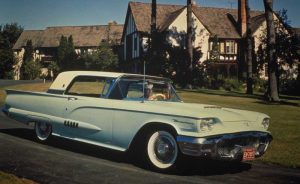
The decision to build a bigger ‘bird was justified by subsequent marketing research that showed, among other things, that: Two-seaters were not being purchased by families with children, unless as a second car. The Seating capacity and price restricted Thunderbird ownership to multi-car, upper income families. A four-passenger car would broaden the market to include the upper income single car owner group. Significant numbers of two-seater owners were interested in a four-passenger model so long as Thunderbird styling was maintained. Five percent of all car buyers interviewed said they would purchase a Thunderbird if seating capacity were increased.
Armed with this rationale, Ford Division ushered in the new 1958 year by unveiling the four-passenger Thunderbird before a group of prominent Americans at a New Year’s Eve Party at the exclusive Thunderbird Golf Club in Palm Springs, Calif. The public introduction was later in January.
The 1958 Thunderbird retained the classic lines of the original Thunderbird, plus some classic styling touches of its own, including the one-piece grille and bumper and clean contemporary roof lines that would set new styling standards for the industry.
It was on a 113-inch wheelbase – 11 inches longer than the original – and overall length was 205.4 inches, 30.4 inches longer. With an overall height of 52.5 inches, it still had a low-slung, relaxed, reverse wedge stance. Shipping weight was 3,799 pounds.
Another leading feature of the 1958 Thunderbird was unit frame construction, and the car boasted “more room per passenger that any luxury car.” Front and rear headroom, according to the press releases, were “within a fraction of an inch of America’s other prestige automobiles.”
Horsepower also was close to that of the significantly bigger luxury cars. The 1958 Thunderbird engine was a 352 CID V-8 with an h.p. rating of 300. Other 1958 styling features included an anodized aluminum honeycomb-pattern grille, twin headlights deeply browed, with the brow line extending into the hood. A flat roof line dropped off to a novel rear window but retained the characteristic Thunderbird treatment in the rear quarter and twin taillights set over a honeycomb-pattern design.
Inside, there were individual bucket seats, and a console that housed controls for the heater, air conditioner and power windows, as well as a radio speaker and ash trays for front and rear passengers.
Classified as a “semi-luxury” car, the 1958 Thunderbird was square in design, with few concessions to rounded corners, front or aft. It solidly established Ford Division in the luxury car market and was a sensation from the time it was introduced.
The standard two-door hardtop carried a suggested retail price of $3,330, but $5,200 was considered an average delivery price. The car lived up to all of its pre-introduction plaudits, and was named Motor Trend Magazine’s “Car of the Year.” Sales totaled 48,482, almost matching two-seater deliveries for all of the three years the model was on the market. Ford management’s decision to drop the smaller car was almost immediately vindicated.
Fittingly, Thunderbird production, starting with the 1958 model, was moved to the company’s Wixom (Mich.) Assembly Plant, where Ford Motor Company’s Lincoln luxury cars are built. As with the two-seaters, the bodies were built by the Budd Company in Philadelphia and shipped to Michigan for assembly.
Two models, a hardtop and a convertible, were offered in 1958. The “little Bird’s” tachometer and adjustable steering wheel were among the deleted items. Gone too was the semi-sports car ride of the two-seater.
The unitized construction of the 1958 Thunderbird was a forerunner of this type construction in the industry, and the 1960 Thunderbird – last of the “Square Bird” designs – was the first American-built car to offer an optional sunroof.
1958 – 1960 Thunderbird
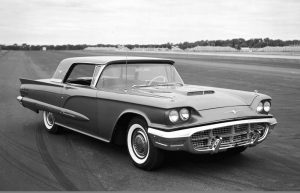
Two models, a hardtop and a convertible, were offered in 1958. The unitized construction (unit frame) of the 1958 Thunderbird was a forerunner of this type of construction in the industry. The 1960 Thunderbird – last of the “Square Bird” designs – was the first American-built car to offer an optional sunroof.
The 1958-60 “Square Birds” became sought by collectors in ever-growing numbers. Despite the popularity of the two-seaters, “Square Bird” enthusiasts have as strong a following as two-seater worshipers. Certainly, there are more 1958-60 models to collect. Ford produced a total of 198,191 of the convertible and two-door Landau models. The Landau models with sunroofs are especially valuable since only a limited number less than 500 were built.
The Square Bird
Thunderbird’s future for the next four decades belonged to the four-seaters. Certainly, the two-seater had given Ford Division the prestigious car it needed, and sales exceeded planning volumes in each of the three years it was on the market.
Economic realities of the times, the public’s motoring needs and Ford’s market share inhibited the potential of the car. Even as the two-seater was being designed, plans for a four-passenger personal car were on Ford’s drawing board.
The decision to build a bigger ‘bird was justified by subsequent marketing research that showed two-seaters were not being purchased by families with children as their primary vehicle. Seating capacity and price restricted Thunderbird ownership to upper-income families.
Ford Division ushered in 1958 by unveiling the four-passenger Thunderbird before a group of prominent Americans at a New Year’s Eve Party at the exclusive Thunderbird Golf Club in Palm Springs, Calif. The public introduction was later in January.
The 1958 Thunderbird retained the classic lines of the original Thunderbird, plus some classic styling touches of its own, including the one-piece grille and bumper and clean contemporary rooflines that would set new styling standards for the industry. It was on a 113-inch wheelbase – 11 inches longer than the original – and its overall length of 205.4 inches was 30.4 inches longer. With an overall height of 52.5 inches, it still had a low-slung, relaxed, reverse wedge stance. Shipping weight was 3,799 pounds.
Another leading feature of the 1958 Thunderbird was unit frame construction, and the car boasted “more room per passenger than any luxury car.” Front and rear headroom, according to the press releases, were “within a fraction of an inch of America’s other prestige automobiles.”
Motor Trend magazine handed the T-Bird its “Car of the Year Award” for 1958, noting Ford’s totally new concept in interior packaging. The MT editors added that “the ride of the new Thunderbird is as comfortable as any American car today, regardless of size.”
Horsepower also was close to that of the significantly bigger luxury cars. The 1958 Thunderbird engine was a 352 CID V-8 with a horsepower rating of 300. Other 1958 styling features included an anodized aluminum honeycomb-pattern grille, twin headlights deeply browed, with the brow line extending into the hood. Inside, there were individual bucket seats, and a console that housed controls for the heater, air conditioner and power windows, as well as a radio speaker and ash trays for front and rear passengers.
Classified as a “semi-luxury” car, the 1958 Thunderbird was square in design, with few concessions to rounded corners, fore or aft. It solidly established Ford Division in the luxury car market and was a sensation from the time it was introduced.
The standard two-door hardtop had a suggested retail price of $3,330, but $5,200 was considered an average delivery price. Sales totaled 48,482; almost matching two-seater deliveries for all of the three years the model was on the market.

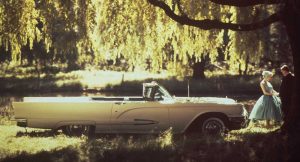
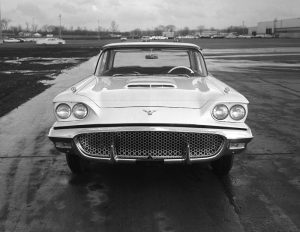
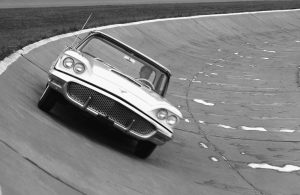
You must be logged in to post a comment.